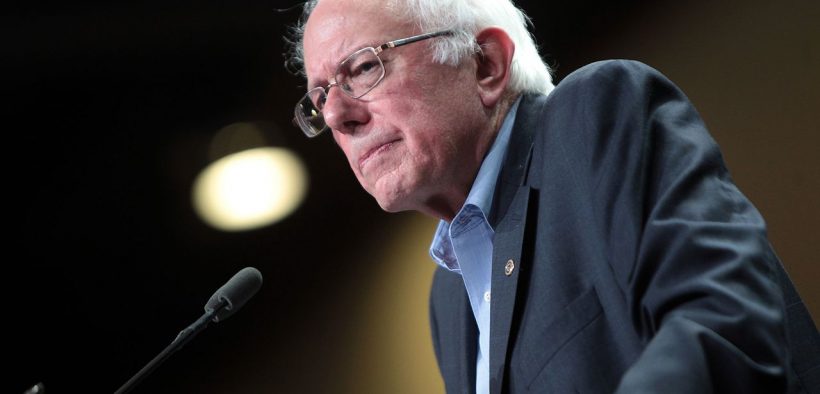Bernie Sanders Unveils Plan To Overhaul Criminal Justice System

There are now more black people in correctional control (prison, jail, probation, or parole) than there were enslaved in 1850.
Sen. Bernie Sanders released a sweeping plan to overhaul America’s criminal justice system on Sunday, seeking to ban private prisons, abolish the death penalty, end cash bail, legalize marijuana and halve the incarcerated population by ending excessive sentencing.
“Due to the historical legacy of institutional racism in this country, mass incarceration disproportionately falls on the shoulders of black and brown people in America,” Sanders’ website reads in a 6,000 word outline of the plan. “In fact, black Americans are incarcerated at five times the rate of white Americans, and even though people use drugs like marijuana at roughly the same rates across all races, black Americans are nearly four times more likely to be arrested for marijuana possession than white Americans.
“These disparities pervade every aspect of the criminal justice system. Black Americans, and especially young black men, are more likely to be stopped by the police, subjected to excessive force, arrested, and jailed than whites.”
The United States incarcerates far more people than any other nation, with 2.3 million people confined nationwide, according to the Prison Policy Initiative (PPI). The PPI describes the “enormous churn” of people in and out of correctional facilities, in large because many are too poor to make bail. Over 460,000 people are being held in jails around the US while they await trial, according to the PPI.
“Can you believe that, in the year 2019, 400,000 people are in jail awaiting a trial because they are poor?” Sanders told the Associated Press. “That is a moral outrage, it is a legal outrage.”
Sanders’ plan will also boost the number of public defenders, end civil-asset forfeiture, ban the prosecution of children under the age of 18 in adult courts, and curtail the use of military equipment by local police, among other measures.
How Did We Get Here?
According to the Sentencing Project, America’s incarcerated population has grown by 500% in the last 40 years, as the War on Drugs has ravaged black and hispanic communities throughout the country.
In her groundbreaking 2010 book The New Jim Crow, legal scholar Michelle Alexander made the case that the War on Drugs “emerged as a stunningly comprehensive and well-designed system of racialized social control that functions in a manner strikingly similar to Jim Crow.”
As William Julius Wilson explained in his 1996 book When Work Disappears, crime rates rose in inner-city communities during the 1960s and 1970s as hundreds of thousands of African Americans lost manufacturing jobs to deindustrialization and globalization. Alexander explains how backlash to the Civil Rights Movement coincided with the rising crime rates, increasing public appetite for tough-on-crime legislation.
But in an interview with Harper’s Dan Baum, President Nixon’s domestic policy advisor John Ehrlichman explained that his administration’s “war on drugs” was never about fighting drug crime:
“The Nixon campaign in 1968, and the Nixon White House after that, had two enemies: the antiwar left and black people. You understand what I’m saying? We knew we couldn’t make it illegal to be either against the war or black, but by getting the public to associate the hippies with marijuana and blacks with heroin. And then criminalizing both heavily, we could disrupt those communities. We could arrest their leaders, raid their homes, break up their meetings, and vilify them night after night on the evening news. Did we know we were lying about the drugs? Of course we did.”
President Reagan ramped up the War on Drugs in 1982 despite declining drug use, pledging to “mobilize all our forces to stop the flow of drugs into this country,” despite illegally funding the Contra rebels of Nicaragua who smuggled cocaine into the country.
Alexander argues Reagan’s crackdown was part of the “Southern Strategy,” a Republican political strategy to win over white southern voters through racism. Recently unearthed recordings reveal Reagan calling African delegates “monkeys” in conversation with Nixon.
Mandatory minimums for non-violent drug offenses, later expanded by Bush and Clinton, exploded the size of America’s incarcerated population. As Alexander explains, Democrats at the time wanted to prove they could be just as tough on crime as Republicans:
“It was the Clinton administration that supported federal legislation denying financial aid to college students who had once been caught with drugs. It was the Clinton administration that passed laws discriminating against people with criminal records, making it nearly impossible for them to have access to public housing. And it was the Clinton administration that championed a federal law denying even food stamps, food support to people convicted of drug felonies.
There are now more black people in correctional control (prison, jail, probation, or parole) than there were enslaved in 1850. In 1954, there were only about 98,000 African Americans in jail. There are now nearly 1 million (913,800), imprisoned at almost six times the rate of whites.
The Sentencing Project estimated that 1 in 3 African American males will spend time incarcerated in a 2013 report. Alexander explains how ex-convicts face tremendous challenges when trying to reintegrate into society, including housing discrimination, ineligibility for public benefits, and employment discrimination.
“When you take a look at the system, when you really step back and take a look at the system, what does the system seem designed to do? It doesn’t seem designed to facilitate people’s re-entry, doesn’t seem designed for people to find work and be stable, productive citizens,” Alexander told PBS Frontline.
“No, if you take a hard look at it, I think the only conclusion that can be reached is that the system as it’s presently designed is designed to send people right back to prison, and that is in fact what happens the vast majority of the time.”
Sanders’ Position On Race
Sanders was criticized by some progressive commentators in 2016 for failing to emphasize the racial dimension in his narrative of exploitation and injustice in American society, but his 2020 presidential campaign seeks to remedy that weakness, according to his national press secretary Briahna Joy Gray.
Progressive activist and Intercept columnist Shaun King, who has criticized Sanders’ stance on race in the past, praised the Vermont senator’s proposal in a tweet:
“Proud. @BernieSanders personally assembled one of the best teams ever formed to ask and answer this fundamental question: How do we radically change the justice system? All of it. And he studied every part of this plan to make it his own. It has 1000s of pages of sources.”














The privitized and very profitable U.S. prison industry — one more powerful special interest bent on defeating Sanders. Special interests win, everyone else loses. Botanists are familiar with the phenomenon: parasites killing the host organism.
“The first and last aim of the politician is to get votes, and the safest of all ways to get votes is to appear to the plain man to be a plain man like himself, which is to say, to appear to him to be happily free from any heretical treason to the body of accepted platitudes — to be filled to the brim with the flabby, banal, childish notions that challenge no prejudice and lay no burden of examination upon the mind.
“In the face of this singular passion for conformity, this dread of novelty and originality, it is obvious that the man of vigorous mind and stout convictions is gradually shouldered out of public life.
“…when a candidate for public office faces the voters he does not face men of sense; he faces a mob of men whose chief distinguishing mark is the fact that they are quite incapable of weighing ideas, or even of comprehending any save the most elemental — men whose whole thinking is done in terms of emotion, and whose dominant emotion is dread of what they cannot understand…”
__ HL Mencken